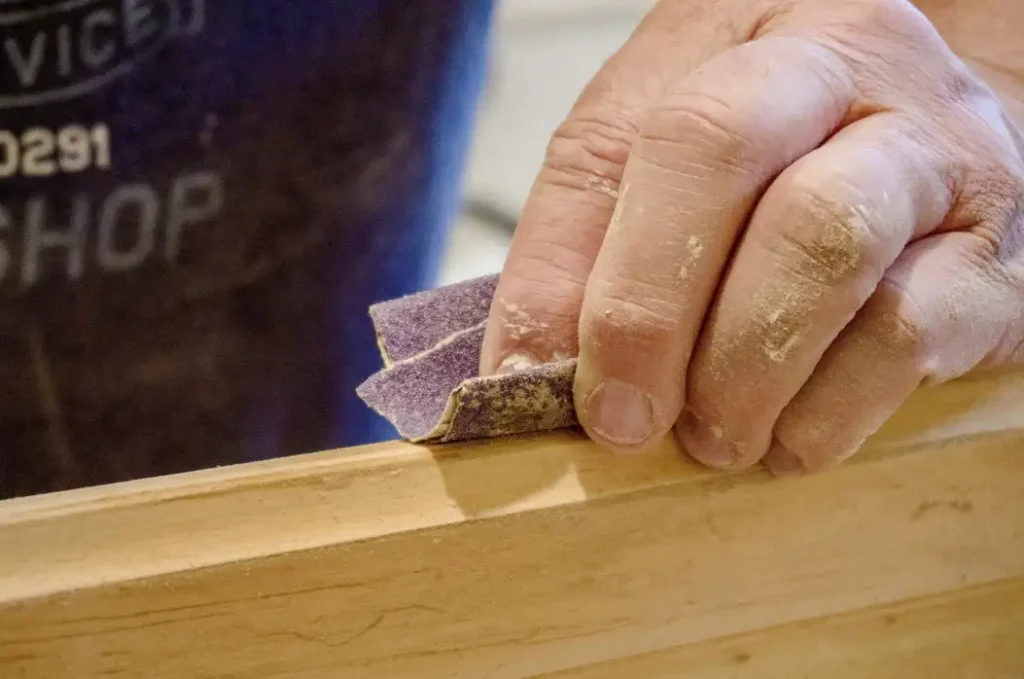While sanding woodwork, you’ve probably noticed that creating a smooth surface is often more hassle than it’s worth. Sanding creates dust, and as anyone who has opened a can of the stuff can tell you, the dust isn’t the kind of stuff that stays in the air for long. So, what is a good substitute for sandpaper? Let’s explore some options in detail.
How to choose sandpaper?
The lower the number, the coarser the grit. The higher the number, the finer the sandpaper. Coarse sandpaper leaves deeper scratches, so you have to start with the finest sandpaper that will work on the project and work your way up to finer grits.
Sandpaper is rated numerically according to the size of the grit particles. Different sandpaper grits perform jobs. Selecting the grit is confusing when you are starting.
Select the right size of grit and choose the appropriate coarseness for the project. Consider the best type of grit to choose, and get the right tool for the effort.

After completing a few completed projects under your belt, you will gain experience in picking just the right sandpaper. When shopping for sandpaper, you will see numbers. They appear as 80-grit, 100-grit, or 200-grit. The higher the number, the smaller the grains and the sandpaper grit.
To make choosing sandpaper easier, manufacturers identify a coarseness level on the package. That is a range of grit sizes for the same sanding work. Know what each project level includes. Choose 80 to 120 grit sandpaper. For heavy sanding and stripping, use coarse sandpaper measuring 40 to 60 grit. For finishing surfaces, use extra-fine sandpaper with 360 to 400 grit.
Sandpaper alternative for wood
Need a substitute for sandpaper? Instead of the sandpaper, use sand and a piece of leather or cloth, Pumice (a porous vulcanic Rock), Walnut Shells, Rottenstone, Wood Shavings, Corn Cobs, a Wood File, Scraping, Burnishing, or even building a primitive sanding tool.
Most methods are easy to use, some are exotic, and a few are interesting—all of these result in finishes that will not be useful for every project. When using sand, sprinkle some sand on the wood and use a piece of cloth or leather to rub the wood with the sand.
Corn Cobs work the same way as using sand or Walnut Shells. Ground Walnut Shells smoothen wood surfaces just like the sand. However, it is hard to come by and requires cleaning up afterward.
Pumice is a volcanic rock that is rough and porous. Keep your wood when sanding with the Pumice. Pumice is available in different grids and holds for a long time. The price depends on where you live. When using wood shavings, rub the shavings over the wood surface to polish them.
For scraping, you need a sharp knife. Scrape over the wood along the grain, changing the angle of the knife. That changes how much wood is scraped off. Burnishing is by rubbing either wood, metal, or leather on the piece of wood. Building a primitive sanding tool by gluing some sand to stone is the funniest of all alternatives.
Sandpaper alternative for metal
Emery cloth looks like sandpaper but has a cloth backing in place of paper, making it more durable. The grit on the front is corundum and other minerals such as magnetite and hematite. Emery cloth is sold in sheets, rolls, or bands. The band version works on belt sanders and sanding metals more than wood.
If you do not have emery cloth, you can use steel wool to remove rust from metal or fine finishing work on metal. Steel wool is available in grades from coarse to very fine. They work like sandpaper as they sand and smooth the blades on metal implements such as knives and garden tools. You can also try stone sharpening tools such as oil stones and whetstones.
These are made of natural or synthetic materials and require a drop or two of oil or water to help remove metal filings from the stone. Some whetstones are soaked in water for up to ten minutes before use. Grinding wheels are for use on a bench or pedestal grinder. They deburr metals as the wheels rotate at high speed while you hold and turn the metal.
DIY sandpaper
DIY sandpaper requires a lot of attention. It takes time because you may not get it right on your first try. The project requires some patience, and be careful when attaching things with glue. There are guidelines and ways to follow. Try not to cut more than what is necessary. Sandpaper is out of materials that differ chemically. Sandpapers consist of a single layer of abrasive particles (Britannica).
To make your own sandpaper, you will need:
- Grit (the coarseness of the sandpaper)
- Paper backing
- Adhesive
Step One: Choose the Grit
The grit is what makes the sandpaper abrasive. If you want a very smooth finish, use a high grit number. For rougher projects, use a low grit number.
Step Two: Choose the Paper Backing
Sandpaper is typically made from paper, but you can also find it made from fabric or even rubber. Choose which material will work best for your project based on its durability and how abrasive you need the sandpaper to be.
Step Three: Apply Adhesive
Now it’s time to apply the adhesive. This will be what sticks the grit to the paper backing. You can find adhesive at any hardware store.
Step Four: Attach the Grit
Once the adhesive is applied, stick on the grit. Make sure that it is evenly distributed across the paper backing.
Step Five: Cut the Sandpaper
Now you need to cut the sandpaper to the desired size. You can do this with a sharp knife or a pair of scissors.
Alternative Steps
- Prepare all the materials you need to come up with the best sandpaper. The materials to make sandpaper are a belt sander, paper, pencil, ruler and protractor, scissors, utility knife, and glue.
- Use a pencil or markers to make markings on the paper. Turn the paper and put line marking and angle on it. Measure the angle using the combination square first. Mark and wrap the paper, leaving space for about half an inch.
- Use the utility knife to cut the belt sanding paper that you marked earlier. Cut the other side of the paper and use the same angle to have a match on either side. Leave half an inch space for this.
- Remove the sand from the paper. You must turn over the belt sanding paper to have the sanded part facing upwards. Put a line on the paper, making sure that there is about half an inch between the line and indentation. Use the same line as a control to remove the sand from the paper. Make sure that all edges are clear of sand.
- Put some glue on the back and the sanded part of the other piece. Make sure that the edges fit with each other. The glued parts should be firm. You can achieve that using clamps or two flat objects and pressing the paper pieces together.
Alternatives to sanding
Milk paint works like a finish. You can purchase it as a powder and even whip it up at home. It is a non-toxic and biodegradable paint option for use on wood furniture. If you mix it with an equal part of the bonding agent, you do not need to sand the piece before beginning. The bonding agent works as a primer.
Can you sand without sandpaper?
Yes. You need to use an abrasive material such as sand, pumice, or sandstone. Rub wood along the grain to smooth the surface and remove imperfections. When you have removed marks, move to a finer grade of the abrasive and repeat the process. When you have reached the desired smoothness, you can stop the process.

Sandpaper substitute for plastic
Vinegar works as a substitute for plastic Sandpaper. Vinegar is a weak acid, and it helps smooth the surface. Before sanding, clean off dirt and grime with a mild detergent solution. Use a 50/50 solution of vinegar and water to clean the plastic.
Sandpaper alternative for clay
Take a glass of water and dip your finger or the silicon rubber tool in the water. Run over the surface of your sculpture to smooth it. Do not use too much water, or the clay will start to run. Go over the surface multiple times to get the best results.
3000 grit sandpaper substitute
Using rottenstone powder and rough horsetail provides you with fine results. The 2000 to 3000 grit sandpaper is for buffing.
- Grain and Sheen: Teak Oil versus Danish Oil Uncovered - January 10, 2024
- The Cherry on Top: Crafting the Perfect Cutting Board - January 9, 2024
- Polyurethane Water-Based vs Oil-Based: Choosing the Right Finish - January 8, 2024